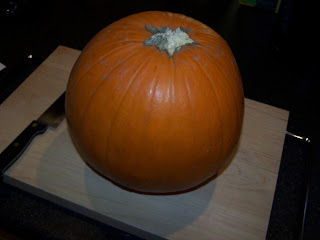Unlike most children, when I was growing up my Mother did not make Banana Bread for me (unlike all the other kids whose mothers made it for them). Instead my Mom made me something even better, she made Pumpkin Bread. Her recipe, resulted in a very strong flavour, partly, ok entirely because she had doubled the amount of spices the original recipe had called for. For my peers it was way to strong of a taste, but for me, I loved it, I reveled in its flavour. The taste of a single bite always brings warm happy memories.
Like my Mother, I started making the recipe with double the spices called for, I have gotten some people addicted to its strong flavour, some but not all. I've always used canned Pumpkin Puree though, just like my Mom. However, in the spirit of things (its fall and Pumpkins are readily available) I have decided to make this ingredient as well. In addition to Pumpkin Bread, the puree can also be used in pies, muffins, waffles, ice cream and whatever whacky creation I can come up with.
In the spirit of making too much, I can't actually turn a whole Pumpkin into loaves of bread and pies and whatever else suits my fancy all at once. I needed to preserve some of it for later use. I originally decided I was going to can the puree for future use, a relatively simple process now that I've done it a few times. I checked the Ball Blue Book (an excellent guide to home canning) for the specifics of how to deal with canning the pumpkin. To my amazement, it recommended against canning, but instead suggested either dehydration or freezing. Dehydration didn't sound appealing, so I have chosen to freeze my puree.
It all began with a pumpkin, there was nothing terribly special about this one, but its mine so I value it more than other pumpkins. I had plans to carve it for Halloween and then turn it into a puree. However I ran out of time and was unable to carve it, that didn't stop me from pureeing it though.
I started by cutting the pumpkin in half, collecting the seeds and chucking the fibrous strands inside. I set the bowl of seeds off to the side in salt water. The seeds will sit over night and be toasted tomorrow. I hadn't planned on making salted toasted pumpkin seeds, that is until I realized just how many seeds were in a pumpkin (way more than I thought).
After cooking the shell for almost an hour and a half, I was able to remove the pulp from the skin and puree it with some sugar. It was a messy job, but as I worked I came up with techniques to help the work go faster.
If I had been planning on canning the puree I would have put more effort into sterilizing the jars. But since I'm freezing them, I just washed them out with warm water. Each jar had the contents and date indelibly etched into the lid for future reference.
I am going to speculate as to why I was recommended against canning, but rather suggested that I freeze the puree. I did a little Googling and found many people detailing how to can a pumpkin puree. However, in each case, they started with a nice light coloured puree and ended up with a much darker coloured one. This makes sense as to properly can something you need to heat it up, to heat it up you enter the realm of "Heat + Food = Cooking". I can only assume that canned purees are cooked purees and frozen ones are uncooked (At least to the extent that it is). I can not speak to the flavour of either, so I am planning on making Pumpkin bread loaves, one from a frozen jar, another I will cook and then make another loaf. I hypothesize that the flavours will be different, but to what extent, well I'll leave that up to the panel of food critics (who ever I can sucker into taste testing) to decide .




No comments:
Post a Comment